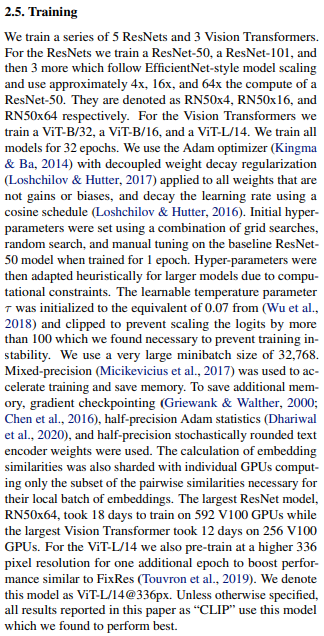A PyTorch Lightning solution to training CLIP from both scratch and fine-tuning.
This training setup is easily usable right outside the box! Simply provide a training directory or your own dataset and we've got the rest covered. To train a model just specify a name from the paper name and tell us your training folder and batch size. All possible models can be seen in the yaml files in models/config
python train.py --model_name RN50 --folder data_dir --batchsize 512
To perform CLIP training much more efficiently, you might be interested in the class CustomCLIPWrapper. This functions as a way to finetune pre-trained image and language models; in turn this leads to a large performance efficiency increase! In order to use this, one simply needs to modify the train_finetune.py file to pass an image encoder and Hugging Face text encoder.
img_encoder = resnet50(pretrained=True)
img_encoder.fc = torch.nn.Linear(2048, 768)
tokenizer = AutoTokenizer.from_pretrained("johngiorgi/declutr-sci-base")
txt_encoder = AutoModel.from_pretrained("johngiorgi/declutr-sci-base")
model = CustomCLIPWrapper(img_encoder, txt_encoder, hparams.minibatch_size, avg_word_embs=True)The command line argument is the same as before minus the --model_name flag:
python train.py --model_name RN50 --folder data_dir --batchsize 512
As long as each of the image pairs have the same stem name (i.e. coco_img1.png and coco_img1.txt) all that you need to do is specify the folder on runtime. Any subfolder structure will be ignored, meaning foo/bar/image1.jpg will always find its myster/folder/image1.txt so long as they share a common parent folder. All image suffixes will work, the only expectation is that captions are separated by \n.
If you have different training needs you may drop in your very own DataLoader. Edit the train.py script to you needs by commenting out our DataModule and inserting your own into trainer.fit(model, your_data). The only expectation is that the first item of the return tuple is the image batch, and the second is the text batch.
Our aim is to create an easy to use Lightning implementation of OpenAI's clip training script. We want our end product to be as inline with the orignal paper as possible. We will live by:
To cite this exact repo feel free to use:
@misc{cg2021trainCLIP,
author = {Cade Gordon},
title = {train-CLIP},
year = {2021},
publisher = {GitHub},
journal = {GitHub repository},
doi = {10.5281/zenodo.4915843},
howpublished = {\url{https://github.com/Zasder3/train-CLIP}}
}
Learning transferable visual models from natural language supervision (a.k.a. CLIP)
@article{radford2021learning,
title={Learning transferable visual models from natural language supervision},
author={Radford, Alec and Kim, Jong Wook and Hallacy, Chris and Ramesh, Aditya and Goh, Gabriel and Agarwal, Sandhini and Sastry, Girish and Askell, Amanda and Mishkin, Pamela and Clark, Jack and others},
journal={arXiv preprint arXiv:2103.00020},
year={2021}
}
Data-Efficient Language-Supervised Zero-Shot Learning with Self-Distillation
@article{cheng2021data,
title={Data-Efficient Language-Supervised Zero-Shot Learning with Self-Distillation},
author={Cheng, Ruizhe and Wu, Bichen and Zhang, Peizhao and Vajda, Peter and Gonzalez, Joseph E},
journal={arXiv preprint arXiv:2104.08945},
year={2021}
}
- Get OpenAI's model creation script
- Create model inits
- ResNet50
- ResNet50x4
- ResNet101
- ViT-B/32
- all models
- Create model wrapper
- Create lightning trainer
- Create dataset files
- Performance boosts
- Mixed-precision
- Self-distillation
- Gradient checkpointing
- Half-precision Adam statistics
- Half-precision stochastically rounded text encoder weights
